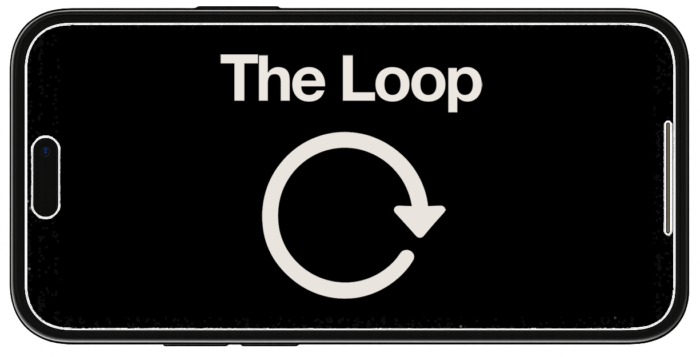Talk about a blast from the past. Last weekend, I was notified when Amanda Bond posted the following about an old experiment that I ran:
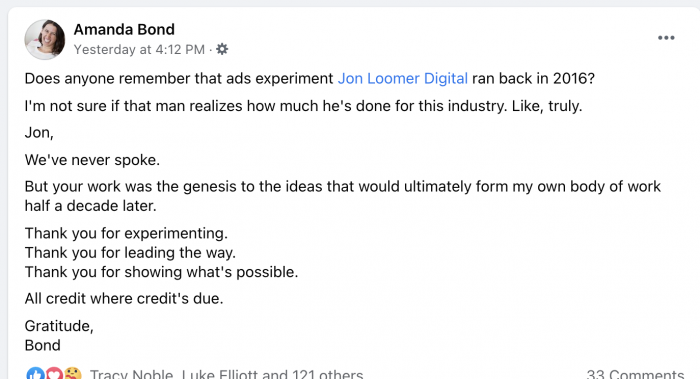
This made me feel a bit warm, fuzzy, and nostalgic because the experiment Amanda referenced is something I’ve long been proud of. It inspired me to go back through how “The Experiment” worked and ask a simple question: Would it still work today?
The result: I’ve started a new experiment for 2021!
The Experiment: The Inspiration
It all occurred to me, one sleepless night in late 2014. Facebook ads were seen as intrusive. Annoying. A necessary evil to be able to use Facebook for free.
But… What if they provided value? What if they served exclusive content that couldn’t be found elsewhere?
What if people looked forward to seeing your ads? And, this is going to sound like a stretch, but…
What if people complained if they didn’t see your ads?
It all sounds crazy, but it’s precisely what happened when I ran The Experiment in early 2015. Ridiculous engagement rates. Low costs. And revenue without even trying to sell something.
How it Worked
Website custom audiences were the backbone of The Experiment in 2015. It all started with an “invitation” ad that went out to people connected to me as well as interests and lookalike audiences (separate ad sets).
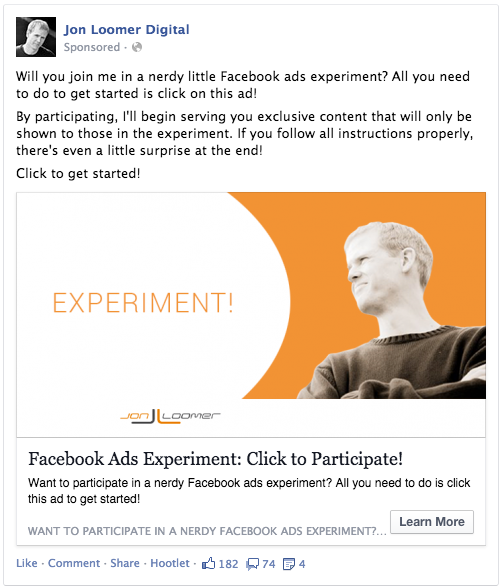
I then created a series of Facebook ads “tips” on hidden pages of my website and promoted those tips with Facebook ads to those who participated. The first tip was shown to those who clicked the invitation ad, indicating they wanted to participate.
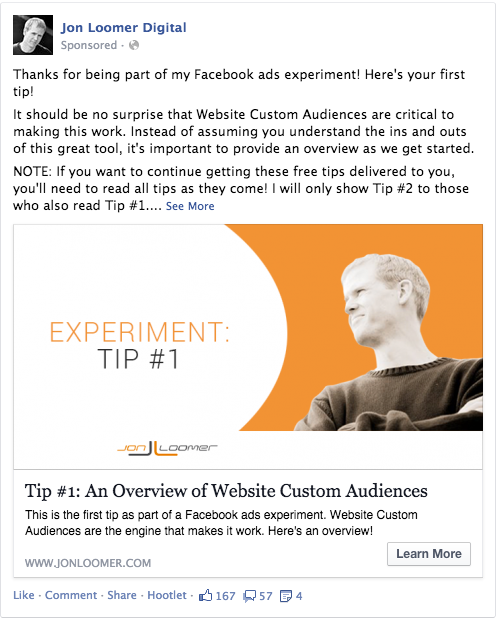
From there, I’d show the second tip to those who engaged with the first tip; I’d show the third tip to those who engaged with the second one; and on and on. The assumption, of course, is that the audience would steadily shrink throughout the experiment.
I also offered an “opt-out” ad. You could click it either instead of joining the experiment or throughout the experiment indicating you’re no longer interested. You would then be added to a special website custom audience that would be excluded throughout the campaigns.
When all was said and done, there were 12 tips. I then invited those who made it that far to a webinar to discuss what I did and how I did it.
The Insane Results
The results were incredible for many reasons, both measurable and immeasurable.
First, the organic distribution. When we run ads, we only get numbers in Ads Manager for those we paid to reach. But, for especially engaging content, you’ll get an organic push as well. People will like, comment, and share.
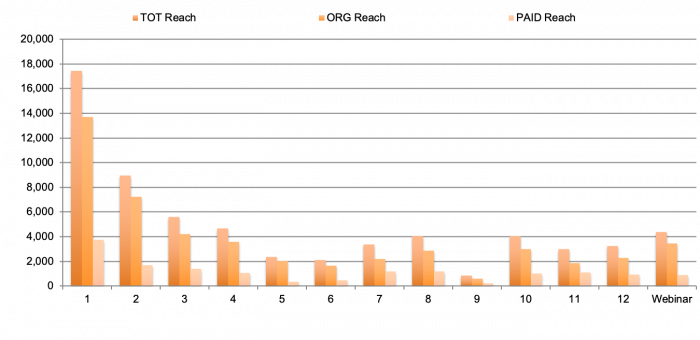
Paid reach actually made up a small percentage of distribution, even though I never published any of the tips organically to my page.
This was possible due to the high engagement rate. The following chart shows the number of people reached and the number of clicks to website per tip.
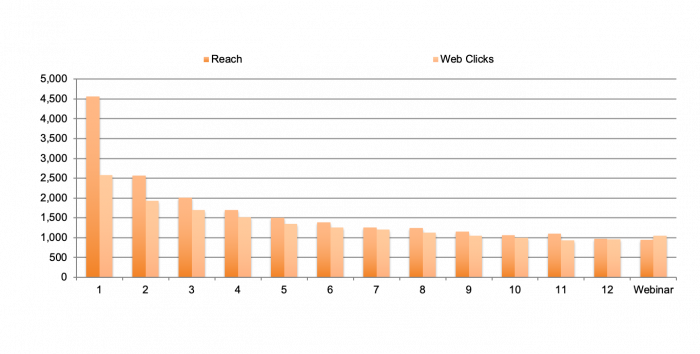
This is insane (I hope you understand how insane this is). While there was attrition (especially as early participants dropped off), people who made it to tip 3 were hyper-engaged. The percentage of people reached who clicked was typically over 90-percent!
Costs were also low. Cost per website click to promote tips was anywhere from $.01 to $.09, depending on the tip. Remember that the audience size we’re dealing with is also very small (under 1,000 people once we reached Tip 4), so we’re talking about peanuts.
But the most amazing was the cost for webinar registrations at the end, offered to those who made it to the final tip. Even though I only promoted that webinar as an ad to this small group, I received more registrations than people reached (they undoubtedly shared it!). My cost per registration was just over $.02.
The Weaknesses in 2015
The funny thing about this experiment was that the biggest weakness was an inability to guarantee I’d reach everyone who wanted to be reached. People actually complained and were frustrated when they weren’t seeing my ads. It was pretty crazy!
First, I used Daily Unique Reach to do all I could to reach everyone in that audience (this was before Reach optimization was available). Facebook’s systems aren’t perfect, so it was impossible to guarantee I’d reach everyone.
But one reason for this was due to using website custom audiences. As great as they were (especially in 2015), browser settings or clearing cookies likely contributed to the failure to add people to audiences.
Why it May Not Work Today or in the Future
First, the elephant in the room: The current environment impacting tracking, the Facebook pixel, and website custom audiences. Browser settings and now iOS 14 make tracking more difficult than it was in 2015. If I were to use website custom audiences this time around, those audiences would be less likely to be complete. I’d run into more problems than I did six years ago.
Another issue is costs and competition. I got crazy results in 2015. Getting crazy results was pretty common for me back then. It’s just harder now because it simply costs more just to reach people. My expectations need to be different.
Finally, I’ve run into more issues with small audiences these days than I did in 2015. I had no issues getting these ads to run when I conducted the initial experiment. But my biggest fear now is that a campaign simply won’t distribute ads.
It’s not due to a clear rule or guideline. When I run Reach campaigns, some small audiences simply don’t go. I need to be prepared for that possibility.
In fact, I ran my 2021 Experiment for a few days first before writing this blog post, fearing it may not run! (NOTE: It’s running!)
How to Recreate The Experiment in Current Environment
The two biggest changes I planned to make with the 2021 Experiment were related to optimization and targeting.
First, I’ll be using Reach optimization instead of Daily Unique Reach. Reach wasn’t available in 2015. While they function very similarly (Facebook attempts to show your ads to as many people within your audience as possible), the biggest difference is related to frequency capping. Daily Unique Reach automatically caps at once per day while I have full flexibility with Reach.
Second, I’m not going to use website custom audiences this time. That pains me a bit, but I think this could actually work better as a result since I don’t have to worry about cookies, browser settings, or iOS 14.
Instead, I’m going to largely keep people on Facebook and use audiences that allow me to isolate engagement with specific pieces of content. They also must allow for durations to control when ads are shown to people.
Format types I’ll be using…
Video. This one’s tricky. I don’t want to use Video View Engagement Audiences for people who only watch a few seconds of a video. That’s not useful. So I’ll need to use long-form videos and create an audience of people who watch 95% of them — assuring that I only include those who truly want to participate.
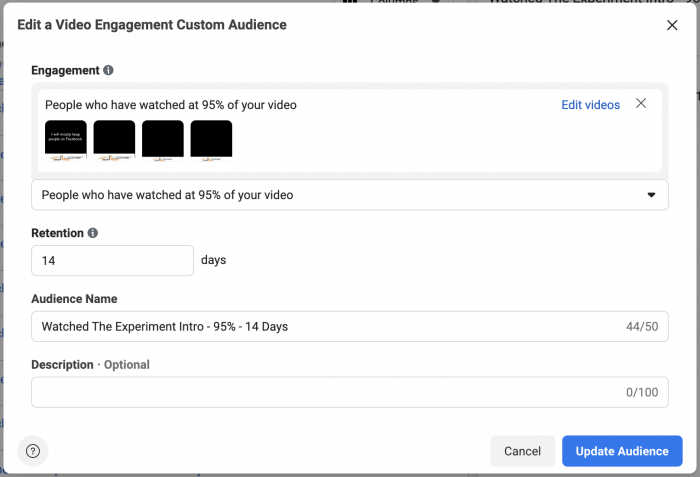
Instant Experience. With this format, I can add a button to it that, when clicked, adds the person to an audience. This would actually be more effective than website custom audiences since it happens within Facebook and I don’t need to worry about browser settings.
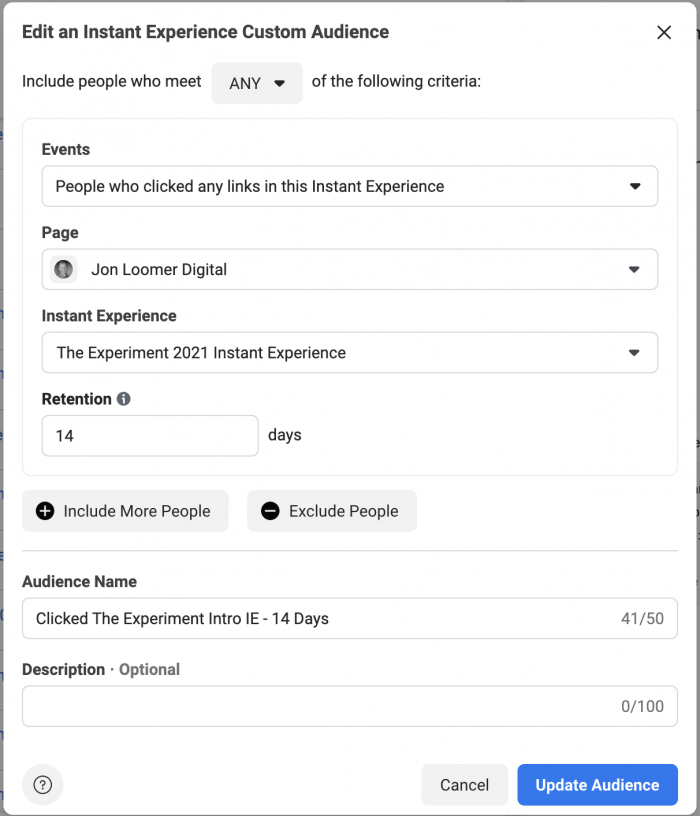
Lead Forms. You can create audiences of people who open or open and submit a form. While this sounds like a high barrier that is best for the end, I wanted to use it creatively. You can actually create a form that doesn’t ask for any personal information. I won’t collect the person’s info, but when submitted they’ll be added to an audience for targeting.
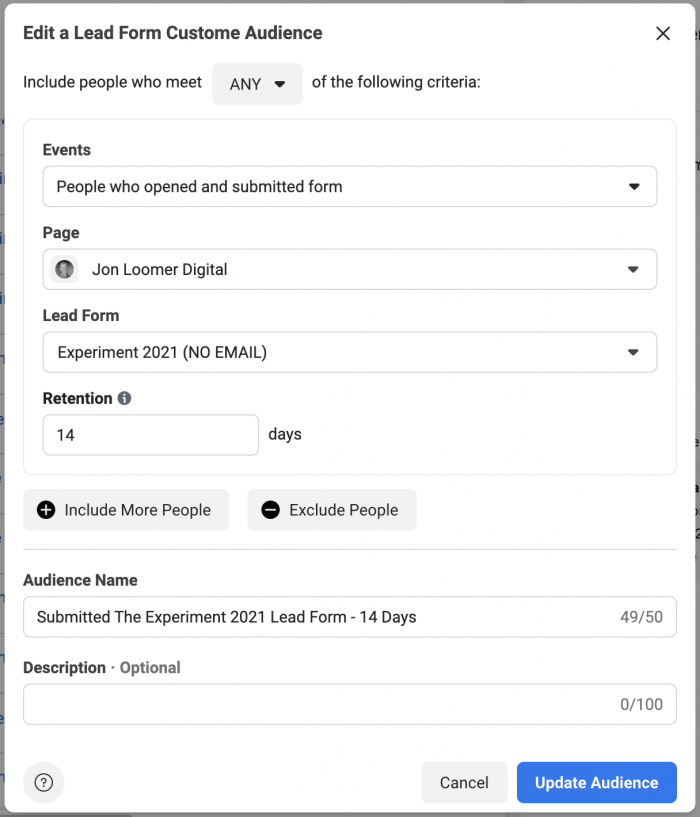
My NEW Experiment
Okay, so here’s how it works…
Like in 2015, it starts with an invitation. I created three different versions for this ad: 3-minute video, Instant Experience, and lead form.
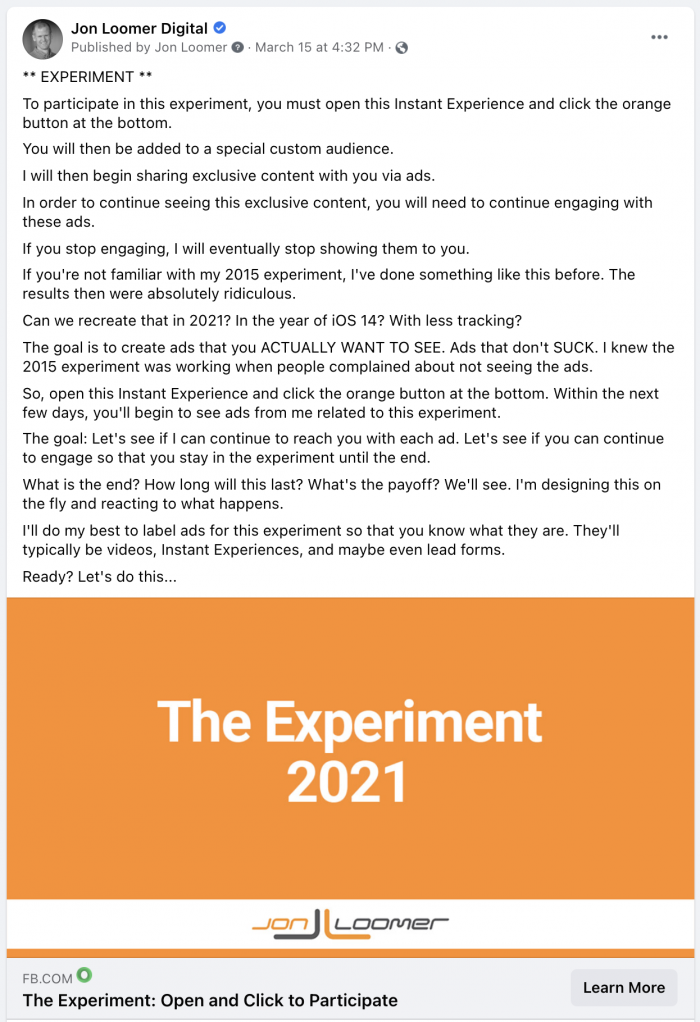
That invitation goes to three different groups:
- Website visitors
- People who engage with my page
- People on my email list
I immediately exclude anyone added to an audience to participate in the experience. I also try to manage frequency by excluding those who performed a lesser action without participating yet (watched a little of the video, opened the form without submitting, or opening the Instant Experience without clicking) for a few days.
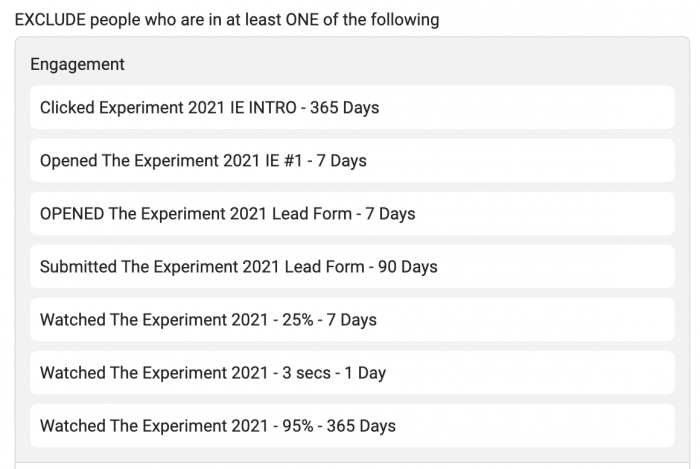
I experimented with both video and an Instant Experience for the first lesson, but I’m going to go with Instant Experience only going forward. Here’s an example of what the targeting looks like for the fourth lesson…
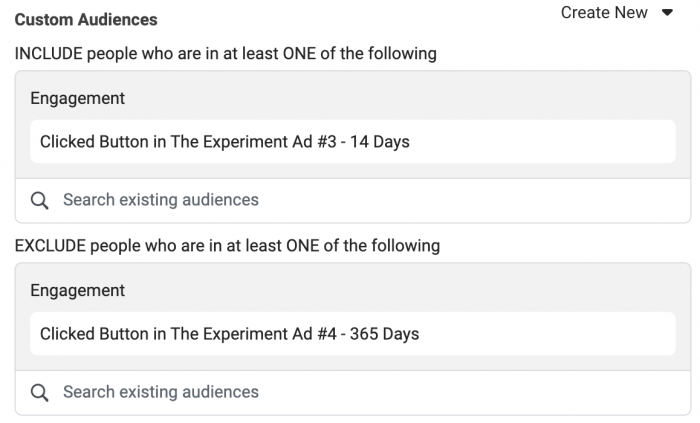
What does this mean? It means only those who clicked the button in the third lesson will see this ad. I’ll exclude you as soon as you click this one. And since it’s a 14-day duration, I’ll stop trying to show it to you after 14 days.
I’m using Worldwide geo-targeting because I want to include everyone who wants to participate (the initial invitation ads are more restricted by country).
I’m only using news feed placements because I’m limiting frequency to once per day (ironically, a recreation of Daily Unique Reach), so I don’t want to waste an impression on a less effective placement.

How Long Will it Go?
For now, I’m planning to keep creating lessons as long as the ad sets keep delivering and people keep clicking. That could mean just about anything. I’m up to four lessons so far.
This is limited mostly by how much I want to spend. For now, I’m spending about $200 per day on the invitation. I’ll likely pull that back eventually. But the more people who accept the invitation, the more people who participate. And the more people who participate, the longer this may go.
Bracing for Roadblocks
I fully expect delivery problems. I’ve had to hold my breath with each new lesson, which seems to take about 12-24 hours before finally delivering after the campaign gets approved.
I already have contingency plans in place if this thing suddenly falls flat and Facebook won’t deliver my ads as the audiences shrink. I can simply create a separate campaign for each tip targeting the full participating audience, excluding those who already engaged with that tip.
Of course, that kind of ruins part of the fun. I want to incentivize participation!
The Prize?
As with the 2015 experiment, I don’t have this completely mapped out yet, and it will come together as we go. Maybe I’ll do an exclusive webinar again for those who make it to the end. Maybe I’ll offer free stuff or discounts. I really don’t know.
But don’t you want to find out??
My Goal
A common question I get is what I’m trying to accomplish with this.
Honestly, it’s just an experiment. I want to try to do things differently. This is an opportunity to get creative and use ads in new and different ways.
I want to create excitement with ads again. I want to see what kind of engagement rates I can get six years later. What will costs be like? Will I be able to reach everyone who wants to participate?
I’m also curious about how we can use formats that keep users on Facebook, since that may be a greater focus in the future.
Bottom line: I want to create ads that don’t suck. I want to generate fresh ideas for how we can use them.
Want to Participate in The Experiment 2021?
So, there are three different ways you can add yourself to The Experiment (you don’t have to do all three!).
2. Open this Instant Experience ON MOBILE ONLY. After opening the ad, follow the instructions and click the button at the bottom.
3. Complete this lead form. You only have to provide your job title!
Any of these three methods will add you to an audience to show you the first lesson.
IMPORTANT: If you’ve already joined The Experiment, don’t do this again. And don’t keep going back to do these things multiple times. Every time you do, it will restart the process (and you’ll be excluded if you already participated).
Fingers Crossed!
I’m really excited about this and can’t wait to see what happens. I hope to see you there!
Let me know below if you have any questions.

